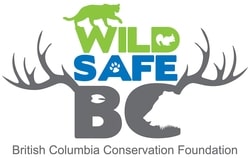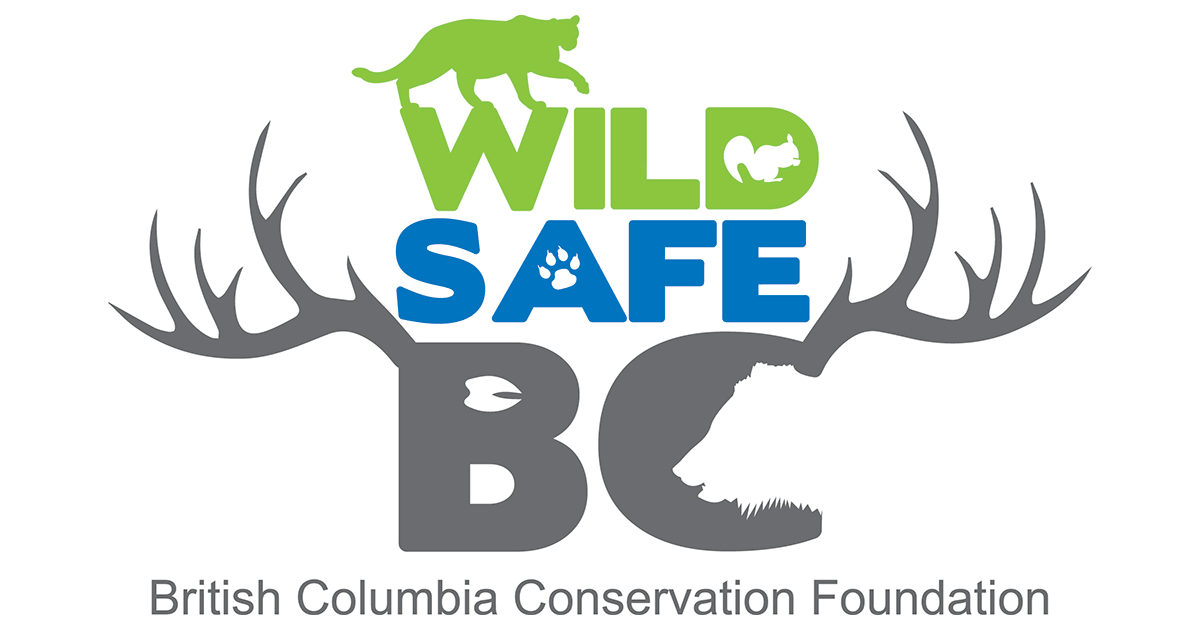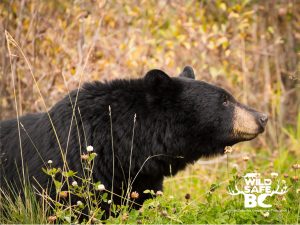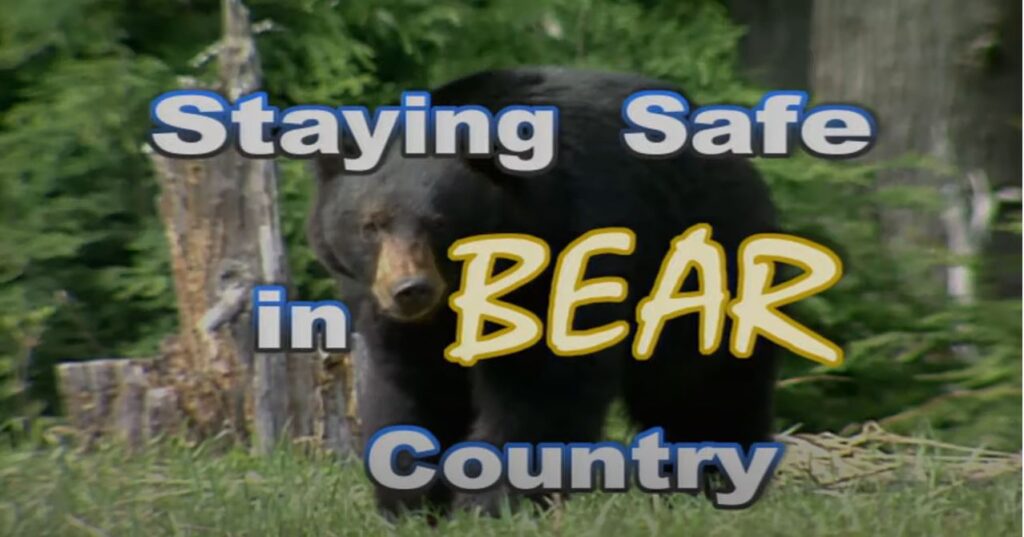Black Bear
Black Bear Snapshot
The American black bear (Ursus americanus) is the most common and widely distributed of the three bears found in Canada. British Columbia has some of the highest populations of black bears in the world with estimates ranging from 120,000 to 150,000 animals. Most of BC is considered “bear country” with bears living in wide variety of ecosystems.
While called a black bear, these animals come in a variety of colours – everything from the white Kermode bear through to their namesake black and most shades of brown in between. Black bears are omnivorous animals with vegetation making up about 80% of their diet. They are renowned for their acute sense of smell that allows them to locate food at great distances.
Black bears account for 14,000 to 25,000 calls per year to the Conservation Officer Service. Bears are most active from April to November, but in milder climates, or where they are continuously finding food, bears may not go into their dens. While most bear encounters result in the bear leaving an area, they can become more assertive or destructive when they have learned to associate humans and their activities with food. All bears that are aggressive in nature, or sightings in urban areas, should be reported to the Conservation Officer Service (1-877-952-7277). These reports can be viewed on WildSafeBC’s Wildlife Alert Reporting Program.
Wild Black Bear Facts
- There are two types of bears in BC: black bear and grizzly bear
- Black bears are typically in dens from December to April when food is less available
- When black bears enter their dens their heart rate drops to about 10 beats per minute and their body temperate drops 3 degrees; they do not eat, drink, urinate or defecate while denning
- Black bears can lose 30% of their body weight over the winter
- In the fall, bears go through hyperphagia (“extreme eating”) when they require an average of 20,000 calories per day
- Black bears are extremely fast and can run equally fast uphill or down
- Black bears are excellent tree climbers
- A black bear has a fine sense of smell that can detect food over 1 km away
- Brown-coloured black bears are often misidentified as grizzly bears
- Males are called boars, females are called sows and their offspring are known as cubs
Identification
When identifying the two types of bears in BC, size and colour can be misleading. Black bears can be white (such as the Kermode bear), bluish-grey, black and various shades of brown. Some are called cinnamon bears for their reddish-brown coat. Some black bears can also be distinguished by unique white blazes on their chest. Adult black bear males measure between 60 to 90 cm at the shoulder and can weigh anywhere from 80 to 300 kg. When trying to identify a species of bear, look at a combination of characteristics and do not rely solely on colour or size.
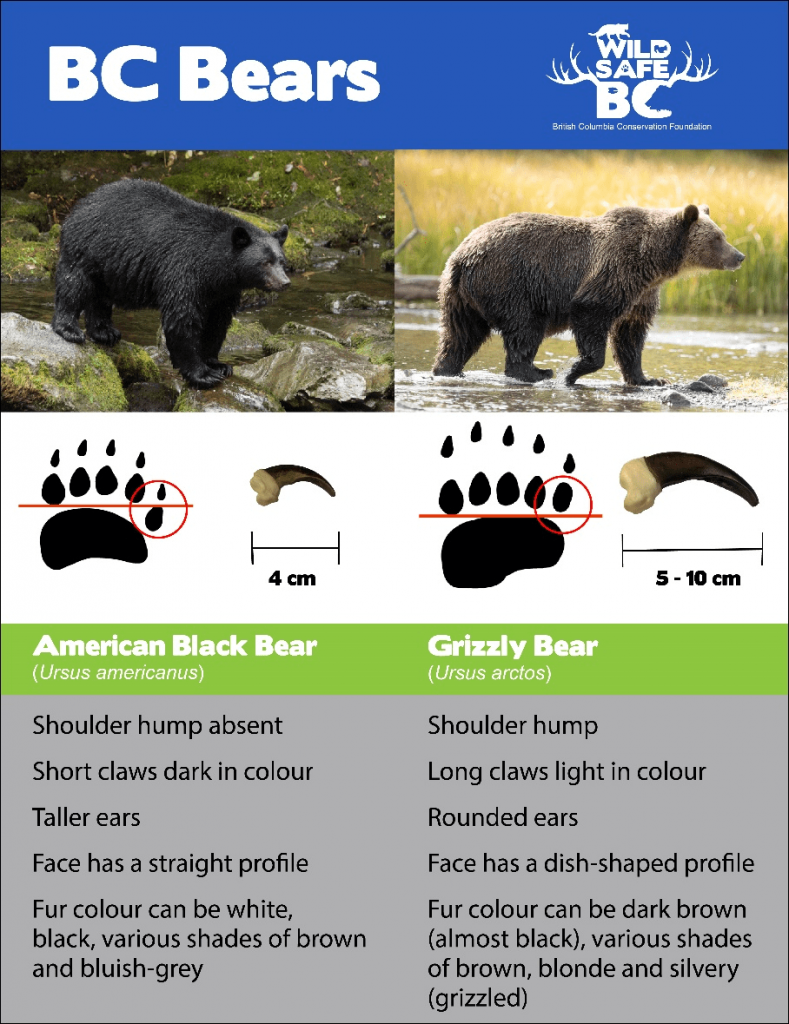
Biology
Black bears are omnivorous mammals with vegetation making up about 80% of their diet. When bears emerge from their dens in April, they seek out lush greens such as grasses, sedges, horsetails and other protein-rich fresh growth. They are one of the few animals that will feed on the tubers of skunk cabbage. Once berries ripen, bears will switch to these high calorie foods. Other foods include rodents, fish, insects (especially the larvae), carrion and sometimes young deer, elk or moose.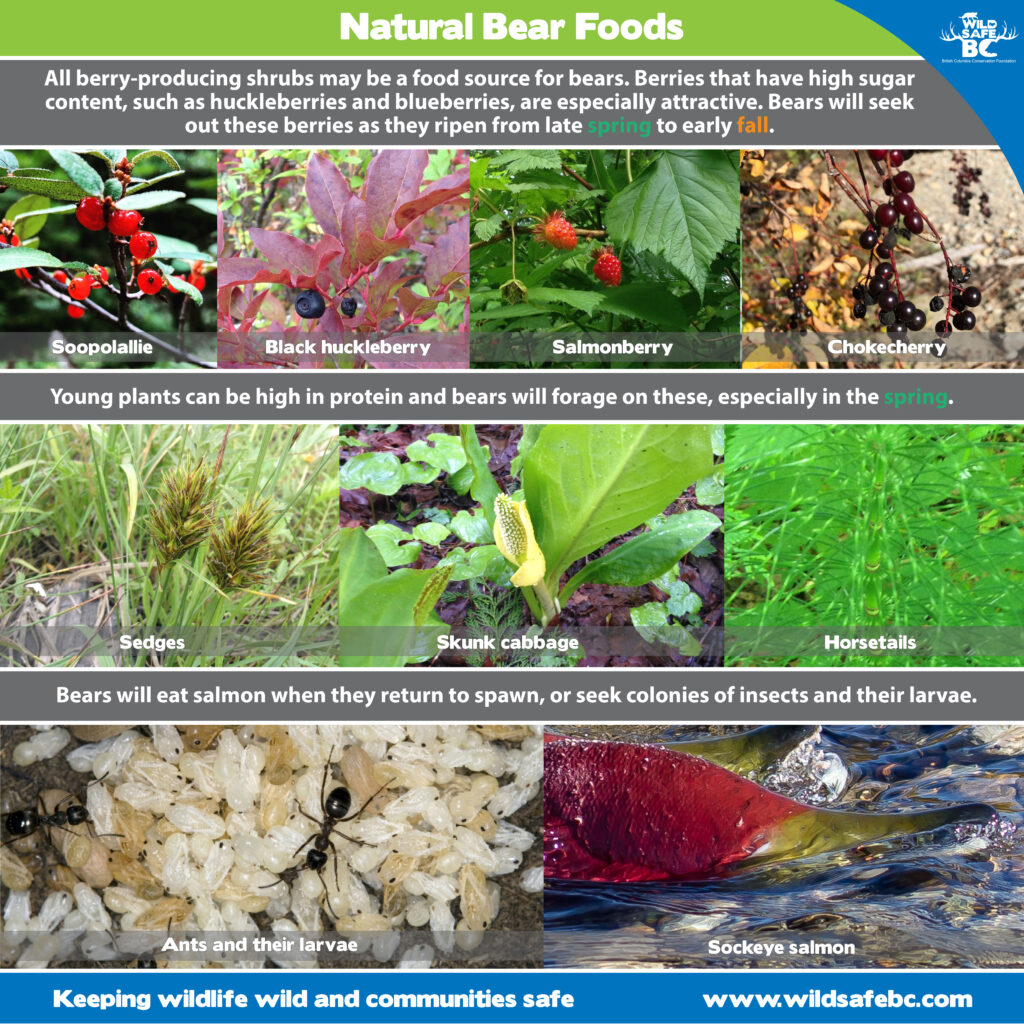
Bears have a sense of smell far greater than that of dogs and can locate food over one kilometre away. Their eyesight and hearing is as good, or better, than humans. The myth that bears have poor eyesight has likely arisen from their habit of standing as if to get a better look. What is more likely is that the bear is standing to pick up a scent.
Black bears have delayed embryo implantation, a process where mating occurs in early summer and the embryo only implants in the fall if the female has sufficient fat reserves to nurse her young over the winter.
Bears go through a phase called hyperphagia (“extreme eating”) in the fall. This is when they try to get as much as 20,000 calories per day to put on stores of fat in preparation for winter denning. Bears lose around 30% of their body weight when they are denning. During this period, typically ranging from November until April, bears will not eat, drink, urinate or defecate while in their dens. They become lethargic and their heart rate drops to about 10 beats per minute. Their body temperature lowers by about 3 degrees. Some black bears, often males, will not den if they can find food sources over the winter.
Females can give birth to up to 5 offspring but twins are typical. Bear cubs are born in late January, blind and helpless, weighing 250 to 500 grams. They will nurse and grow to between 2 and 5 kg in size when they emerge in late April. Females will care for their young for about 2 years.
Black bears can live to over 30 years in age, but 15 to 20 is more typical. Mortality rate for cubs tends to hover around 50%. Young cubs are killed by other black bears, grizzly bears, wolves, coyotes and cougars. Adult black bears have few predators except for grizzly bears and wolves.
Behaviour
Black bears tend to be solitary animals except for females raising cubs, individuals congregating around food sources, or during mating season in late June. Several bears may try to mate with a female and she may have a litter of offspring from different males. If a female has cubs, she will avoid male bears that may try to kill them in order to mate with her.
They have excellent memories and the females teach their offspring where to find food. Females will drive off their young in the spring of their second year when they are ready to mate again. Young females may stay nearby while young males tend to disperse to set up a home range in a new area.
Bears have a hierarchy with mature boars at the top and cubs at the bottom. Juvenile bears and females with offspring will rely on secure travel routes that provide cover from dominant boars. Bears are active during the day (diurnal) however, in higher risk areas, such as those with human activity, they may become more active and feed at night.
Range and Habitat
Black bears are found throughout BC in a variety of ecosystems. Black bears do not have a territory they defend but they will have home ranges. These home ranges usually consist of different feeding areas with travel routes connecting them. Since many communities, ranches and farms are built in prime bear habitat, there are ongoing interactions with bears in many parts of the province.
WildSafe Tales Black Bear Episode
In coastal British Columbia, black bear dens tend to be under large-diameter trees, logs, and stumps and may even be found above ground. If large trees are not available, Interior bears will also use rock cavities, brush piles, or dig into the ground. Bears become quite lethargic when denning but they can be roused if disturbed. In this video, we observe a sow and her "helpful" cubs preparing a den for winter by gathering insulating grasses.
Black Bear Safety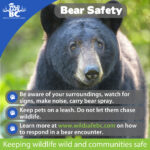
Attacks by black bears are uncommon but can occasionally be fatal. On average there is less than one fatal black bear attack on humans every three years in BC. In comparison, on average, four people are killed and 840 people injured in wildlife vehicle collisions. Having said that, it is important not to be complacent and allow bears to become habituated to humans. Bears that have associated a food reward with human activity and/or become habituated to humans are more likely to come into conflict with people. This can lead to destruction of property as bears try to gain access to food, injuries or death to pets and livestock and increased potential for vehicle collisions. In the end, the bears are likely to suffer and the potential for human injury can increase.
Avoiding Bear Encounters
Surprising a bear or encountering a food-conditioned bear should be avoided. Here are some tips to reduce the chances of this happening:
- Watch for bear signs like scat, tracks, freshly overturned logs, fresh claw marks on trees.
- Talk or sing to avoid surprising a bear. Be cautious around running water, thick brush or high wind that may mask your presence. Bear bells are not recommended as the high-pitched tinkle does not travel as far and is not recognized as a human.
- Be aware of your surroundings and do not use headphones when hiking, biking or running in bear country.
- Manage your attractants and never put someone else at risk by leaving organics behind. Pack out what you pack in. Tossing organics (apple cores and banana peels) can attract wildlife to a roadside which may result in a vehicle collision.
- Avoid hiking alone. Travelling with another person results in more noise and may also help dissuade a bear from approaching.
- Keep pets leashed or under control when in bear country. In a review of black bear attacks, dogs were involved in over 50% of black bear inflicted injuries on humans*. Dogs may be perceived as a potential threat or prey.
- Use extra caution in bear habitat and where sightlines are poor. This includes berry bushes with ripe fruit, salmon-bearing streams and other areas bears are known to frequent.
- If you find a carcass leave the area immediately and notify the Conservation Officer Service and/or landowner.
- Take training such as a Wildlife Awareness and Safety Course offered by WildSafeBC that shows the “Staying Safe in Bear Country” video. A summary of the video content is available here.
- Carry bear spray and be able to access it quickly. Do not carry it in your pack or attached to your bike. Learn more on our Bear Spray page.
- Learn more. If heading to a Provincial or Federal park, check their websites for wildlife alerts or safety considerations. When travelling, check in with locals and visitor centres to find out about local wildlife activity. Become knowledgeable about where you may encounter bears through WildSafeBC’s Wildlife Alert Reporting Program.
*Hristienko and Herrero. 2014. Are dogs “saviours” or are they contributing factors in black bear attacks on people? International Bear News Vol 23 (1).
Special Note about Mountain Biking and Running
When mountain biking or running, you may be travelling relatively quietly and at a higher rate of speed. This can increase your chances of surprising a bear. Also, the higher speed may also trigger a chase response. Slow down around blind corners and call out more frequently to avoid surprising a bear.
Special Note about Camping
When camping in bear country, learn about “bare camping” best practices and follow them to avoid attracting a bear to your campsite.
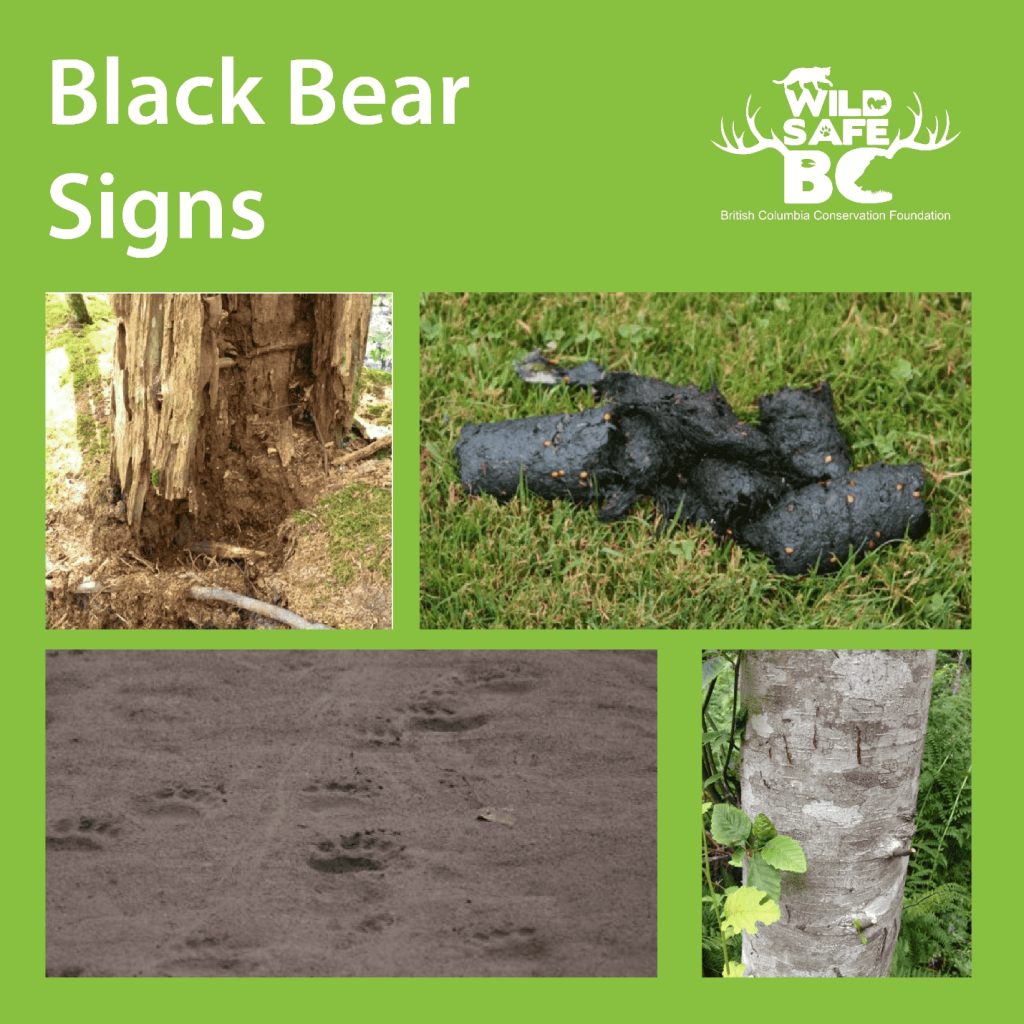
Bear Encounters in the Wild
If you encounter a bear, stop, stay calm and NEVER RUN. Most bears are wary of humans and tend to avoid us. Black bears evolved in wooded habitat so they are more inclined to flee into the forest rather than engage. However a bear defending a kill or a female bear, especially grizzly sows, can be protective. Occasionally, black bears may show predatory behaviour where they approach quietly and intently. What you do next depends on the bear’s behaviour.
- A bear that is unaware. Leave the area quietly and go back the way you came while keeping an eye on the bear. Check your bear spray in case you need to pull it out quickly.
- A bear that is aware but not reacting to your presence. Speak softly, back away slowly. If the bear leaves, let it do so and do not follow it.
- A bear that seems agitated will make noises such as jaw-popping, moaning, woofing and may even stomp the ground or bluff charge. These are all signs of a bear behaving defensively and letting you know you are too close. Speak softly and calmly and back away slowly. Do not make direct eye contact but keep the bear in sight. Pull out your bear spray and be prepared to use it. If the bear charges, stand your ground and discharge the bear spray when the bear is in range (5 to 10 m). Most bluff charges stop short of contact but you may be knocked down (see below).
- A bear that is steadily approaching you. The bear may simply be wanting to use the same path you are on. Yield to the bear slowly. If the bear continues to approach, this is a dangerous situation where the bear may be predatory. In this case you want to yell at the bear and get onto higher ground. Be prepared to fight for your life if the bear attacks. If you have bear spray have it ready to use when the bear is in range (5 to 10 m).
If a bear makes physical contact, how you react depends on the nature of the attack. A defensive bear attack is usually a result of a surprise encounter where a bear is protecting itself, its food source or its cubs. If it is a defensive attack by a grizzly or black bear that knocks you down, the best defense is to lie still on your stomach, protect the back of your head by clasping your hands, and spread your feet slightly apart to avoid getting rolled over. Once the bear feels that you are no longer a threat, the attack will stop. Stay still and do not get up until you are sure the bear has left the area.
If the attack does not stop and the bear tries to consume you then you are dealing with a predatory attack. You must fight off the bear with everything at hand by focusing on the bear’s face, eyes and nose. In both cases, having bear spray, and knowing how to use it, can significantly increase your chances of avoiding contact at all.
For more details and training, take a Wildlife Awareness and Safety Course and watch the “Staying Safe in Bear Country” video.
You can also find a summary of the video content here.
Special Note About Roadside Encounters
If you see a bear along the roadside, it may be trying to cross or it is feeding on lush vegetation or berry-producing shrubs. Use caution and slow down but do not stop, especially on highways where speeds are in excess of 60 km/hr. If it is safe to do so (on a quiet road on a straightaway), you may be inclined to pull over. Note that this can lead to habituation of both humans and vehicles. If you do pull over, stay in your vehicle, stay a respectful distance away and do not linger. If taking photos, be respectful of your subject and abide by WildSafeBC’s Photographer Code of Conduct.
Conflict Reduction with Black Bears
Since we share the same landscape with bears, it stands to reason that there are going to be times when bears will be in our living space (just as we are often in theirs). As long as a bear is moving through our community, is not lingering, and is not interacting with us or our property then there is no conflict. There are many situations when a bear moving through the community is to be expected: e.g. when they are trying to access a natural food source such as a fish bearing stream or trying to get to foraging opportunities on the other side of what was once their normal home range.
When bears quit moving through the community and start using the community as a foraging area for human-provided foods, then conflicts develop. Bears that start using human-provided foods (anthropogenic foods in the words of the biologists) can become food-conditioned. Once a bear starts equating humans with food, they can lose their natural wariness of humans and become what is called human-habituated (often simply referred to as being habituated). A habituated bear tolerates humans in much closer proximity than what is safe for both bears and humans. This increases the potential for a dangerous interaction between the bears and us.
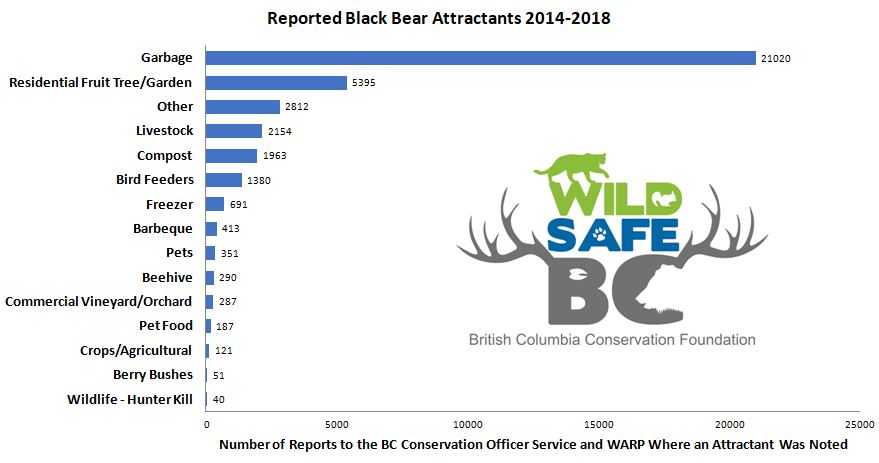
We can help reduce conflicts with bears by securing attractants and preventing bears from becoming food-conditioned in the first place. It is unfortunate that garbage is reported in 60% of the calls to the Conservation Officer Service when an attractant is identified. While fruit from domestic trees may seem harmless for bears, it leads to food-conditioning and draws them into our communities which increases interactions and conflicts with people. This may make your neighbours, young and young at heart, feel unsafe in their own backyards or using community trails. You can help your community by securing your attractants.
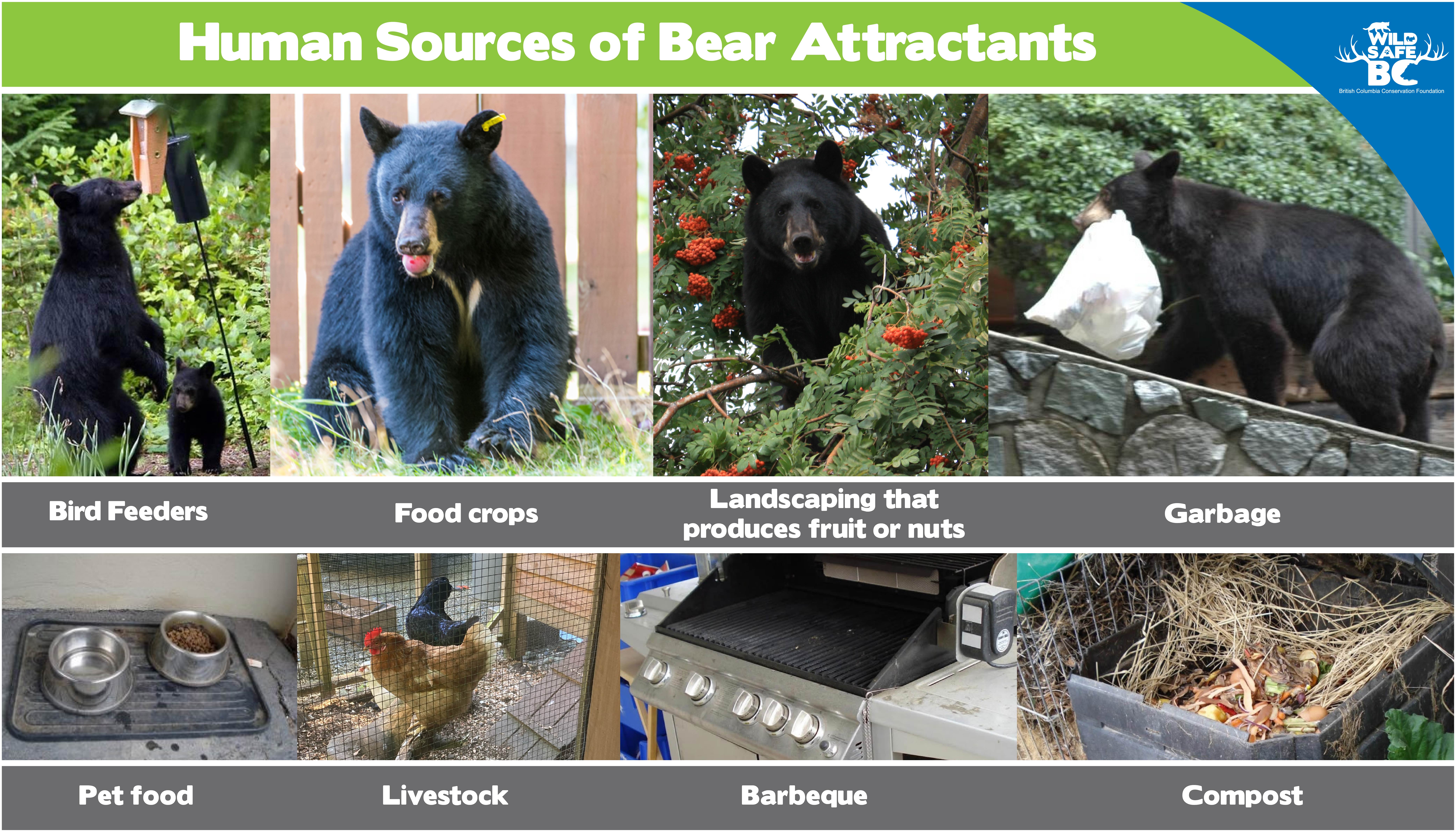
Garbage
Keep garbage secure at all times, preferably indoors or in a secure structure. Keep them tightly closed to reduce smells. Approved bear-resistant containers can be used but they are still best stored inside or secured to a post with chain. Never set your garbage out the night before as this is when bears are most likely to be active. If you cannot store garbage securely, freeze smelly items and only add them to your bin on the morning of collection. Reduce smells by regularly cleaning your waste and recycling bins. Always make sure your recyclables are clean before adding them to your bin.
Pets and Pet Food
Feed your pets indoors. If you must feed pets outside, only put out what they will immediately consume and bring the dirty dish inside. Store pet food in a secure location indoors.
Barbeques
Clean barbeques after each use by burning of the bits of food at high heat and then giving the grill a good scrub. It is then ready for your next use. Also remove and clean the grease trap after each use as this is a strong attractant. A bear can do significant damage to a barbeque trying to access this high calorie food source. If possible, cover and store indoors (leaving the propane tank outside) especially if bears are frequently in your area.
Bird Feeders
Birdseed is a very good source of calories for bears and other wildlife. A kilogram of sunflower seeds has approximately 8,000 calories – about 20 times the caloric reward a bear would get from grazing the same weight of wild clover. Also note that the seed that drops to the ground can attract rodents such as rats. Use bird feeders only in the winter when bears are hibernating and natural bird food is limited. Bears have also been known to drink the syrup from hummingbird feeders.
Fruit Trees
Fruit trees are a consistent and predictable source of high calorie foods. Bears often inflict damage to fruit trees when accessing their fruit or to surrounding fences and other structures. A well-managed fruit tree is pruned to have a healthy and manageable harvest. Pick fruit early and allow it to ripen indoors or pick daily as it ripens. Do not allow windfall to accumulate on the ground. If you do not want the fruit, prune the tree vigorously to prevent blossoms or spray spring blossoms with a garden hose to knock them off. If you would like to make the fruit available to others, contact a local fruit exchange program or food bank. Electric fencing is also an excellent way to protect your harvest. If you no longer want to manage your tree, consider replacement with a native, non-fruit bearing variety. Remember, domestic fruit is to feed people not bears.
Berry Bushes
Like in the wild, bears will be attracted to berries growing in your garden. Pick the berries often as they ripen or consider replacing with non-fruiting varieties if you do not want the fruit. Electric fencing can also be used to protect berry bushes and gardens.
Landscaping
While planting native species is generally recommended, there are some precautions that should be taken when living in bear country. Avoid planting native or non-native plants that are strong bear attractants near your home. These include fruit or berry producing trees and shrubs such as Sitka mountain-ash (Sorbus sitchensis), any of the blueberries and huckleberries (Vaccinium species) and ground covers such as the non-native clover and native sedges. Nut-bearing trees such as oak trees are also a strong attractant for bears. An excellent list of recommended and non-recommended species was developed by the City of Coquitlam that is appropriate for the Lower Mainland and Vancouver Island.
Livestock, Apiaries and Feed
Keep feed secured indoors. Keep chickens and small livestock in at night and use electric fencing to protect them. Keeping urban chickens and beehives is increasing in popularity but can also bring bears in close to our homes. Apiaries, chickens coops and runs should be protected by electric fencing that is kept energized day and night. Check out our electric fencing resource page.
Keep vulnerable young animals close to the home and protected with electric fencing. Don’t bury carcasses in areas where you wish to exclude bears.
Fish and Smokehouses
When fishing for food, gut your catch at the shoreline if possible and throw all the wasted parts into deep water. Leaving fish on the shoreline can attract bears and be a hazard for others. When processing large quantities of fish or using outdoor smokehouses, use electric fencing to protect your harvest until it can be brought inside.
Other Resource Pages on this Site:
Growing in Wildlife Country
Living in Wildlife Country
Working in Wildlife Country
Playing in Wildlife Country
Bare Camping
Electric Fencing
Bear Spray
Black Bear Snapshot
The American black bear (Ursus americanus) is the most common and widely distributed of the three bears found in Canada. British Columbia has some of the highest populations of black bears in the world with estimates ranging from 120,000 to 150,000 animals. Most of BC is considered “bear country” with bears living in wide variety of ecosystems.
While called a black bear, these animals come in a variety of colours – everything from the white Kermode bear through to their namesake black and most shades of brown in between. Black bears are omnivorous animals with vegetation making up about 80% of their diet. They are renowned for their acute sense of smell that allows them to locate food at great distances.
Black bears account for 14,000 to 25,000 calls per year to the Conservation Officer Service. Bears are most active from April to November, but in milder climates, or where they are continuously finding food, bears may not go into their dens. While most bear encounters result in the bear leaving an area, they can become more assertive or destructive when they have learned to associate humans and their activities with food. All bears that are aggressive in nature, or sightings in urban areas, should be reported to the Conservation Officer Service (1-877-952-7277). These reports can be viewed on WildSafeBC’s Wildlife Alert Reporting Program.
Wild Black Bear Facts
- There are two types of bears in BC: black bear and grizzly bear
- Black bears are typically in dens from December to April when food is less available
- When black bears enter their dens their heart rate drops to about 10 beats per minute and their body temperate drops 3 degrees; they do not eat, drink, urinate or defecate while denning
- Black bears can lose 30% of their body weight over the winter
- In the fall, bears go through hyperphagia (“extreme eating”) when they require an average of 20,000 calories per day
- Black bears are extremely fast and can run equally fast uphill or down
- Black bears are excellent tree climbers
- A black bear has a fine sense of smell that can detect food over 1 km away
- Brown-coloured black bears are often misidentified as grizzly bears
- Males are called boars, females are called sows and their offspring are known as cubs
Identification
When identifying the two types of bears in BC, size and colour can be misleading. Black bears can be white (such as the Kermode bear), bluish-grey, black and various shades of brown. Some are called cinnamon bears for their reddish-brown coat. Some black bears can also be distinguished by unique white blazes on their chest. Adult black bear males measure between 60 to 90 cm at the shoulder and can weigh anywhere from 80 to 300 kg. When trying to identify a species of bear, look at a combination of characteristics and do not rely solely on colour or size.

Biology
Black bears are omnivorous mammals with vegetation making up about 80% of their diet. When bears emerge from their dens in April, they seek out lush greens such as grasses, sedges, horsetails and other protein-rich fresh growth. They are one of the few animals that will feed on the tubers of skunk cabbage. Once berries ripen, bears will switch to these high calorie foods. Other foods include rodents, fish, insects (especially the larvae), carrion and sometimes young deer, elk or moose.
Bears have a sense of smell far greater than that of dogs and can locate food over one kilometre away. Their eyesight and hearing is as good, or better, than humans. The myth that bears have poor eyesight has likely arisen from their habit of standing as if to get a better look. What is more likely is that the bear is standing to pick up a scent.
Black bears have delayed embryo implantation, a process where mating occurs in early summer and the embryo only implants in the fall if the female has sufficient fat reserves to nurse her young over the winter.
Bears go through a phase called hyperphagia (“extreme eating”) in the fall. This is when they try to get as much as 20,000 calories per day to put on stores of fat in preparation for winter denning. Bears lose around 30% of their body weight when they are denning. During this period, typically ranging from November until April, bears will not eat, drink, urinate or defecate while in their dens. They become lethargic and their heart rate drops to about 10 beats per minute. Their body temperature lowers by about 3 degrees. Some black bears, often males, will not den if they can find food sources over the winter.
Females can give birth to up to 5 offspring but twins are typical. Bear cubs are born in late January, blind and helpless, weighing 250 to 500 grams. They will nurse and grow to between 2 and 5 kg in size when they emerge in late April. Females will care for their young for about 2 years.
Black bears can live to over 30 years in age, but 15 to 20 is more typical. Mortality rate for cubs tends to hover around 50%. Young cubs are killed by other black bears, grizzly bears, wolves, coyotes and cougars. Adult black bears have few predators except for grizzly bears and wolves.
Behaviour
Black bears tend to be solitary animals except for females raising cubs, individuals congregating around food sources, or during mating season in late June. Several bears may try to mate with a female and she may have a litter of offspring from different males. If a female has cubs, she will avoid male bears that may try to kill them in order to mate with her.
They have excellent memories and the females teach their offspring where to find food. Females will drive off their young in the spring of their second year when they are ready to mate again. Young females may stay nearby while young males tend to disperse to set up a home range in a new area.
Bears have a hierarchy with mature boars at the top and cubs at the bottom. Juvenile bears and females with offspring will rely on secure travel routes that provide cover from dominant boars. Bears are active during the day (diurnal) however, in higher risk areas, such as those with human activity, they may become more active and feed at night.
Range and Habitat
Black bears are found throughout BC in a variety of ecosystems. Black bears do not have a territory they defend but they will have home ranges. These home ranges usually consist of different feeding areas with travel routes connecting them. Since many communities, ranches and farms are built in prime bear habitat, there are ongoing interactions with bears in many parts of the province.
WildSafe Tales Black Bear Episode
In coastal British Columbia, black bear dens tend to be under large-diameter trees, logs, and stumps and may even be found above ground. If large trees are not available, Interior bears will also use rock cavities, brush piles, or dig into the ground. Bears become quite lethargic when denning but they can be roused if disturbed. In this video, we observe a sow and her "helpful" cubs preparing a den for winter by gathering insulating grasses.
Black Bear Safety
Attacks by black bears are uncommon but can occasionally be fatal. On average there is less than one fatal black bear attack on humans every three years in BC. In comparison, on average, four people are killed and 840 people injured in wildlife vehicle collisions. Having said that, it is important not to be complacent and allow bears to become habituated to humans. Bears that have associated a food reward with human activity and/or become habituated to humans are more likely to come into conflict with people. This can lead to destruction of property as bears try to gain access to food, injuries or death to pets and livestock and increased potential for vehicle collisions. In the end, the bears are likely to suffer and the potential for human injury can increase.
Avoiding Bear Encounters
Surprising a bear or encountering a food-conditioned bear should be avoided. Here are some tips to reduce the chances of this happening:
- Watch for bear signs like scat, tracks, freshly overturned logs, fresh claw marks on trees.
- Talk or sing to avoid surprising a bear. Be cautious around running water, thick brush or high wind that may mask your presence. Bear bells are not recommended as the high-pitched tinkle does not travel as far and is not recognized as a human.
- Be aware of your surroundings and do not use headphones when hiking, biking or running in bear country.
- Manage your attractants and never put someone else at risk by leaving organics behind. Pack out what you pack in. Tossing organics (apple cores and banana peels) can attract wildlife to a roadside which may result in a vehicle collision.
- Avoid hiking alone. Travelling with another person results in more noise and may also help dissuade a bear from approaching.
- Keep pets leashed or under control when in bear country. In a review of black bear attacks, dogs were involved in over 50% of black bear inflicted injuries on humans*. Dogs may be perceived as a potential threat or prey.
- Use extra caution in bear habitat and where sightlines are poor. This includes berry bushes with ripe fruit, salmon-bearing streams and other areas bears are known to frequent.
- If you find a carcass leave the area immediately and notify the Conservation Officer Service and/or landowner.
- Take training such as a Wildlife Awareness and Safety Course offered by WildSafeBC that shows the “Staying Safe in Bear Country” video. A summary of the video content is available here.
- Carry bear spray and be able to access it quickly. Do not carry it in your pack or attached to your bike. Learn more on our Bear Spray page.
- Learn more. If heading to a Provincial or Federal park, check their websites for wildlife alerts or safety considerations. When travelling, check in with locals and visitor centres to find out about local wildlife activity. Become knowledgeable about where you may encounter bears through WildSafeBC’s Wildlife Alert Reporting Program.
*Hristienko and Herrero. 2014. Are dogs “saviours” or are they contributing factors in black bear attacks on people? International Bear News Vol 23 (1).
Special Note about Mountain Biking and Running
When mountain biking or running, you may be travelling relatively quietly and at a higher rate of speed. This can increase your chances of surprising a bear. Also, the higher speed may also trigger a chase response. Slow down around blind corners and call out more frequently to avoid surprising a bear.
Special Note about Camping
When camping in bear country, learn about “bare camping” best practices and follow them to avoid attracting a bear to your campsite.

Bear Encounters in the Wild
If you encounter a bear, stop, stay calm and NEVER RUN. Most bears are wary of humans and tend to avoid us. Black bears evolved in wooded habitat so they are more inclined to flee into the forest rather than engage. However a bear defending a kill or a female bear, especially grizzly sows, can be protective. Occasionally, black bears may show predatory behaviour where they approach quietly and intently. What you do next depends on the bear’s behaviour.
- A bear that is unaware. Leave the area quietly and go back the way you came while keeping an eye on the bear. Check your bear spray in case you need to pull it out quickly.
- A bear that is aware but not reacting to your presence. Speak softly, back away slowly. If the bear leaves, let it do so and do not follow it.
- A bear that seems agitated will make noises such as jaw-popping, moaning, woofing and may even stomp the ground or bluff charge. These are all signs of a bear behaving defensively and letting you know you are too close. Speak softly and calmly and back away slowly. Do not make direct eye contact but keep the bear in sight. Pull out your bear spray and be prepared to use it. If the bear charges, stand your ground and discharge the bear spray when the bear is in range (5 to 10 m). Most bluff charges stop short of contact but you may be knocked down (see below).
- A bear that is steadily approaching you. The bear may simply be wanting to use the same path you are on. Yield to the bear slowly. If the bear continues to approach, this is a dangerous situation where the bear may be predatory. In this case you want to yell at the bear and get onto higher ground. Be prepared to fight for your life if the bear attacks. If you have bear spray have it ready to use when the bear is in range (5 to 10 m).
If a bear makes physical contact, how you react depends on the nature of the attack. A defensive bear attack is usually a result of a surprise encounter where a bear is protecting itself, its food source or its cubs. If it is a defensive attack by a grizzly or black bear that knocks you down, the best defense is to lie still on your stomach, protect the back of your head by clasping your hands, and spread your feet slightly apart to avoid getting rolled over. Once the bear feels that you are no longer a threat, the attack will stop. Stay still and do not get up until you are sure the bear has left the area.
If the attack does not stop and the bear tries to consume you then you are dealing with a predatory attack. You must fight off the bear with everything at hand by focusing on the bear’s face, eyes and nose. In both cases, having bear spray, and knowing how to use it, can significantly increase your chances of avoiding contact at all.
For more details and training, take a Wildlife Awareness and Safety Course and watch the “Staying Safe in Bear Country” video.
You can also find a summary of the video content here.
Special Note About Roadside Encounters
If you see a bear along the roadside, it may be trying to cross or it is feeding on lush vegetation or berry-producing shrubs. Use caution and slow down but do not stop, especially on highways where speeds are in excess of 60 km/hr. If it is safe to do so (on a quiet road on a straightaway), you may be inclined to pull over. Note that this can lead to habituation of both humans and vehicles. If you do pull over, stay in your vehicle, stay a respectful distance away and do not linger. If taking photos, be respectful of your subject and abide by WildSafeBC’s Photographer Code of Conduct.
Conflict Reduction with Black Bears
Since we share the same landscape with bears, it stands to reason that there are going to be times when bears will be in our living space (just as we are often in theirs). As long as a bear is moving through our community, is not lingering, and is not interacting with us or our property then there is no conflict. There are many situations when a bear moving through the community is to be expected: e.g. when they are trying to access a natural food source such as a fish bearing stream or trying to get to foraging opportunities on the other side of what was once their normal home range.
When bears quit moving through the community and start using the community as a foraging area for human-provided foods, then conflicts develop. Bears that start using human-provided foods (anthropogenic foods in the words of the biologists) can become food-conditioned. Once a bear starts equating humans with food, they can lose their natural wariness of humans and become what is called human-habituated (often simply referred to as being habituated). A habituated bear tolerates humans in much closer proximity than what is safe for both bears and humans. This increases the potential for a dangerous interaction between the bears and us.

We can help reduce conflicts with bears by securing attractants and preventing bears from becoming food-conditioned in the first place. It is unfortunate that garbage is reported in 60% of the calls to the Conservation Officer Service when an attractant is identified. While fruit from domestic trees may seem harmless for bears, it leads to food-conditioning and draws them into our communities which increases interactions and conflicts with people. This may make your neighbours, young and young at heart, feel unsafe in their own backyards or using community trails. You can help your community by securing your attractants.

Garbage
Keep garbage secure at all times, preferably indoors or in a secure structure. Keep them tightly closed to reduce smells. Approved bear-resistant containers can be used but they are still best stored inside or secured to a post with chain. Never set your garbage out the night before as this is when bears are most likely to be active. If you cannot store garbage securely, freeze smelly items and only add them to your bin on the morning of collection. Reduce smells by regularly cleaning your waste and recycling bins. Always make sure your recyclables are clean before adding them to your bin.
Pets and Pet Food
Feed your pets indoors. If you must feed pets outside, only put out what they will immediately consume and bring the dirty dish inside. Store pet food in a secure location indoors.
Barbeques
Clean barbeques after each use by burning of the bits of food at high heat and then giving the grill a good scrub. It is then ready for your next use. Also remove and clean the grease trap after each use as this is a strong attractant. A bear can do significant damage to a barbeque trying to access this high calorie food source. If possible, cover and store indoors (leaving the propane tank outside) especially if bears are frequently in your area.
Bird Feeders
Birdseed is a very good source of calories for bears and other wildlife. A kilogram of sunflower seeds has approximately 8,000 calories – about 20 times the caloric reward a bear would get from grazing the same weight of wild clover. Also note that the seed that drops to the ground can attract rodents such as rats. Use bird feeders only in the winter when bears are hibernating and natural bird food is limited. Bears have also been known to drink the syrup from hummingbird feeders.
Fruit Trees
Fruit trees are a consistent and predictable source of high calorie foods. Bears often inflict damage to fruit trees when accessing their fruit or to surrounding fences and other structures. A well-managed fruit tree is pruned to have a healthy and manageable harvest. Pick fruit early and allow it to ripen indoors or pick daily as it ripens. Do not allow windfall to accumulate on the ground. If you do not want the fruit, prune the tree vigorously to prevent blossoms or spray spring blossoms with a garden hose to knock them off. If you would like to make the fruit available to others, contact a local fruit exchange program or food bank. Electric fencing is also an excellent way to protect your harvest. If you no longer want to manage your tree, consider replacement with a native, non-fruit bearing variety. Remember, domestic fruit is to feed people not bears.
Berry Bushes
Like in the wild, bears will be attracted to berries growing in your garden. Pick the berries often as they ripen or consider replacing with non-fruiting varieties if you do not want the fruit. Electric fencing can also be used to protect berry bushes and gardens.
Landscaping
While planting native species is generally recommended, there are some precautions that should be taken when living in bear country. Avoid planting native or non-native plants that are strong bear attractants near your home. These include fruit or berry producing trees and shrubs such as Sitka mountain-ash (Sorbus sitchensis), any of the blueberries and huckleberries (Vaccinium species) and ground covers such as the non-native clover and native sedges. Nut-bearing trees such as oak trees are also a strong attractant for bears. An excellent list of recommended and non-recommended species was developed by the City of Coquitlam that is appropriate for the Lower Mainland and Vancouver Island.
Livestock, Apiaries and Feed
Keep feed secured indoors. Keep chickens and small livestock in at night and use electric fencing to protect them. Keeping urban chickens and beehives is increasing in popularity but can also bring bears in close to our homes. Apiaries, chickens coops and runs should be protected by electric fencing that is kept energized day and night. Check out our electric fencing resource page.
Keep vulnerable young animals close to the home and protected with electric fencing. Don’t bury carcasses in areas where you wish to exclude bears.
Fish and Smokehouses
When fishing for food, gut your catch at the shoreline if possible and throw all the wasted parts into deep water. Leaving fish on the shoreline can attract bears and be a hazard for others. When processing large quantities of fish or using outdoor smokehouses, use electric fencing to protect your harvest until it can be brought inside.
Other Resource Pages on this Site:
Growing in Wildlife Country
Living in Wildlife Country
Working in Wildlife Country
Playing in Wildlife Country
Bare Camping
Electric Fencing
Bear Spray
